Philips OLED769 is the entry-level OLED model from the Dutch manufacturer for 2024, but don’t let that mislead you. OLED769 surprises with its image quality and several interesting features. Thanks to OLED technology, the colours are truly vivid, and the contrast is very good – deep blacks and bright highlights displayed on this screen make a difference, especially when watching evening series. When it comes to motion fluidity, OLED769 performs really well. The 120 Hz panel handles dynamic scenes excellently, whether it's sports or games. When it comes to gaming on consoles, the television does not disappoint either – 4 HDMI 2.1 ports support VRR and ALLM, and the fast response time ensures smooth and responsive gameplay. And what about Ambilight? It’s a classic Philips feature and one of those functions that either you love or hate. In this model, it works very well – the backlighting responds to the content on the screen and adds atmosphere, particularly in a dark room. It’s not something that everyone will consider essential, but it does make an impression in the evenings – at least on us. As for the new operating system TitanOS, it leaves us with mixed feelings. It operates quickly, but some popular applications are missing. For more demanding users, it might lack the flexibility that earlier Philips systems (GoogleTV) offered. Philips OLED769 is a good choice for those looking for a television with beautiful image quality and the exceptional addition of Ambilight. The image quality and motion fluidity will satisfy most users, and the minor limitations of the operating system will not be a hindrance if you prioritise basic applications. It’s a solid option for both watching films and gaming.
- Matching (Score)
- Our verdict
- TV appearance
- Where to buy
- Contrast and black detail
- HDR effect quality
- Factory color reproduction
- Color reproduction after calibration
- Smoothness of tonal transitions
- Image scaling and smoothness of tonal transitions
- Blur and motion smoothness
- Console compatibility and gaming features
- Input lag
- Compatibility with PC
- Viewing angles
- TV efficiency during daytime
- Details about the matrix
- TV features
- Apps
- Playing files from USB
- Sound
Philips OLED769 vs Hisense U7Q PRO
Direct compare
OLED769 / AMIBLIGHT TV
U7Q PRO / U78Q PRO


Panel type: WRGB OLED
Resolution: 3840x2160
System: Titan OS
Model year: 2024
Complete the survey to find out the result

Panel type: LCD VA
Resolution: 3840x2160
System: VIDAA
Model year: 2025
Complete the survey to find out the result

Overall rating
7.3
7.4
Movies and series in UHD quality
7.6
7.2
Classic TV, YouTube
8.4
7.1
Sports broadcasts (TV and apps)
8.3
6.7
Gaming on console
9.2
8.3
TV as a computer monitor
7.6
8.2
Watching in bright light
4.6
6.2
Utility functions
5.6
9.4
Apps
6.2
7.7
Sound quality
6.7
7.8
Complete the survey to find out what fits your preferences
Advantages
Great contrast
Perfect choice for gamers and sports - HDMI 2.1, 120Hz, low input lag
3-sided Ambilight system
Excellent colour reproduction after calibration
Excellent contrast and black levels - true Mini-LED backlighting with a VA panel (65")
Very good motion smoothness - 4K@165 Hz panel
Very high HDR brightness - even above 1500 nits
Ideal for gaming - Low input lag, VRR, ALLM, 4x HDMI 2.1, 288Hz at 1080p.
The Vidaa operating system has many features such as Airplay, USB recording
Outstanding quality of tonal transitions
Disadvantages
Poorly developed operating system - TitanOS
Average brightness
No support for HGiG
Average viewing angles
Missing apps on the VIDAA platform
Our verdict
The U7Q PRO is a television that, after just a few minutes, sends a clear signal: "speed matters here." Hisense surprised us with how much has been packed into a device that doesn't cost a fortune. A refresh rate of 165 Hz in 4K, and even 288 Hz in Full HD – until recently, such numbers were reserved exclusively for top-tier gaming monitors. And here we have a mid-range television with almost a complete set of features for gamers, confidently throwing down the gauntlet to much pricier competitors. However, it doesn't stop at speed-related attributes. The U7Q PRO also boasts a very bright screen, reaching up to 1500 nits at its peak. Like every Mini-LED, it has its typical "quirks" associated with this technology, sometimes slightly exaggerating the image, but the overall visual effect remains very positive – especially in HDR content. It's also worth mentioning the Vidaa operating system – fast, intuitive, and equipped with features such as AirPlay, a voice assistant, and a web browser. While we won't find the full range of applications known from Android, the system performs really well in everyday use. So why is it "almost" ideal for gamers? The only missing feature is HGiG, which allows for precise adjustments of brightness levels in HDR games. This is a minor flaw, but it may be significant for console purists. Nevertheless, the U7Q PRO remains a very solid proposition – and a testament that Chinese manufacturers have not only caught up with their competition from Korea and Japan but in some aspects have even begun to surpass it.
TV appearance
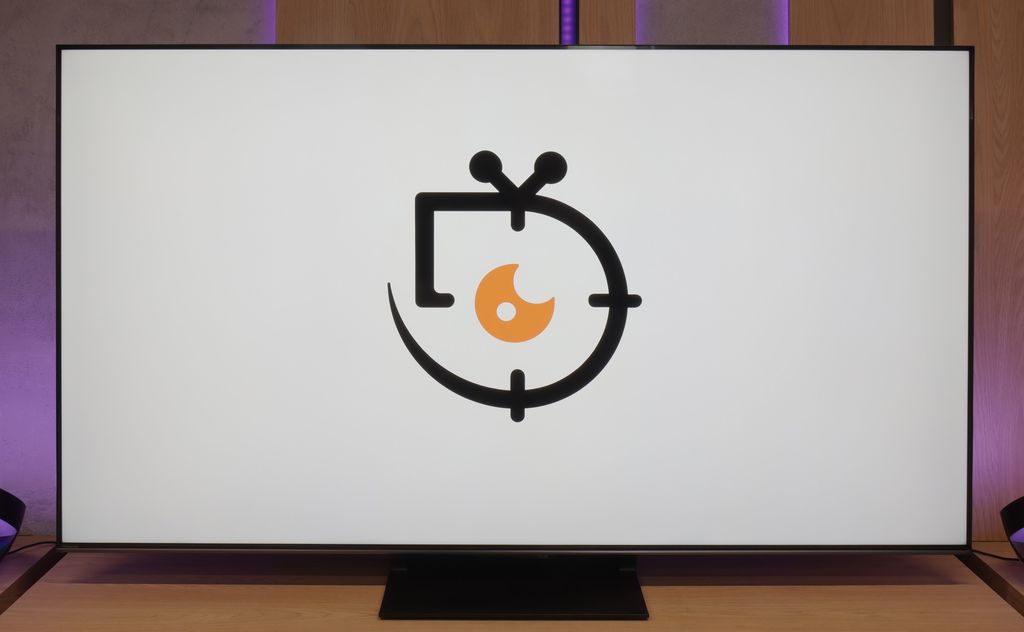
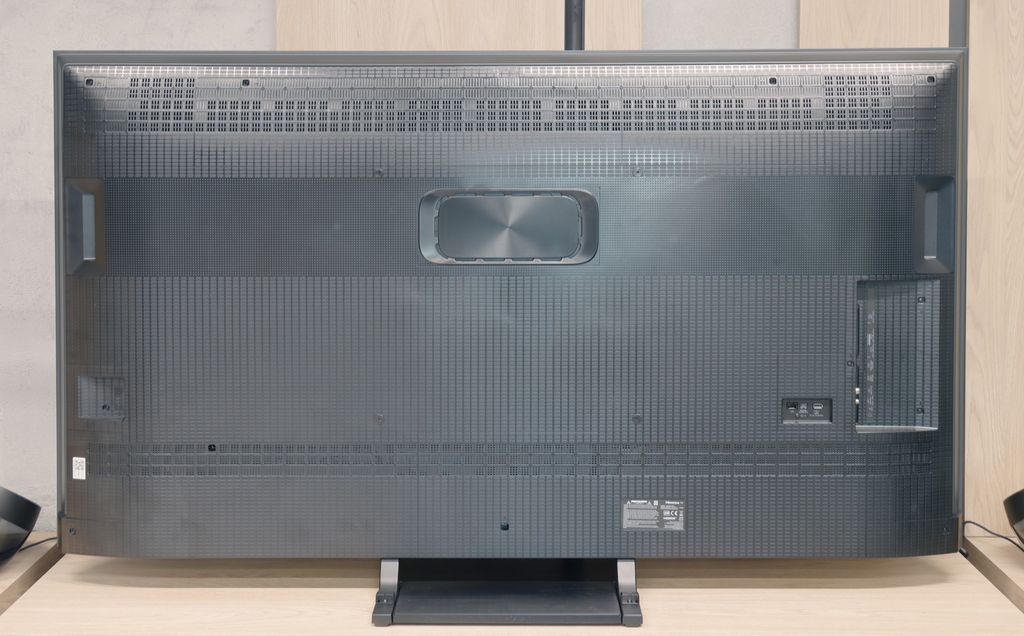
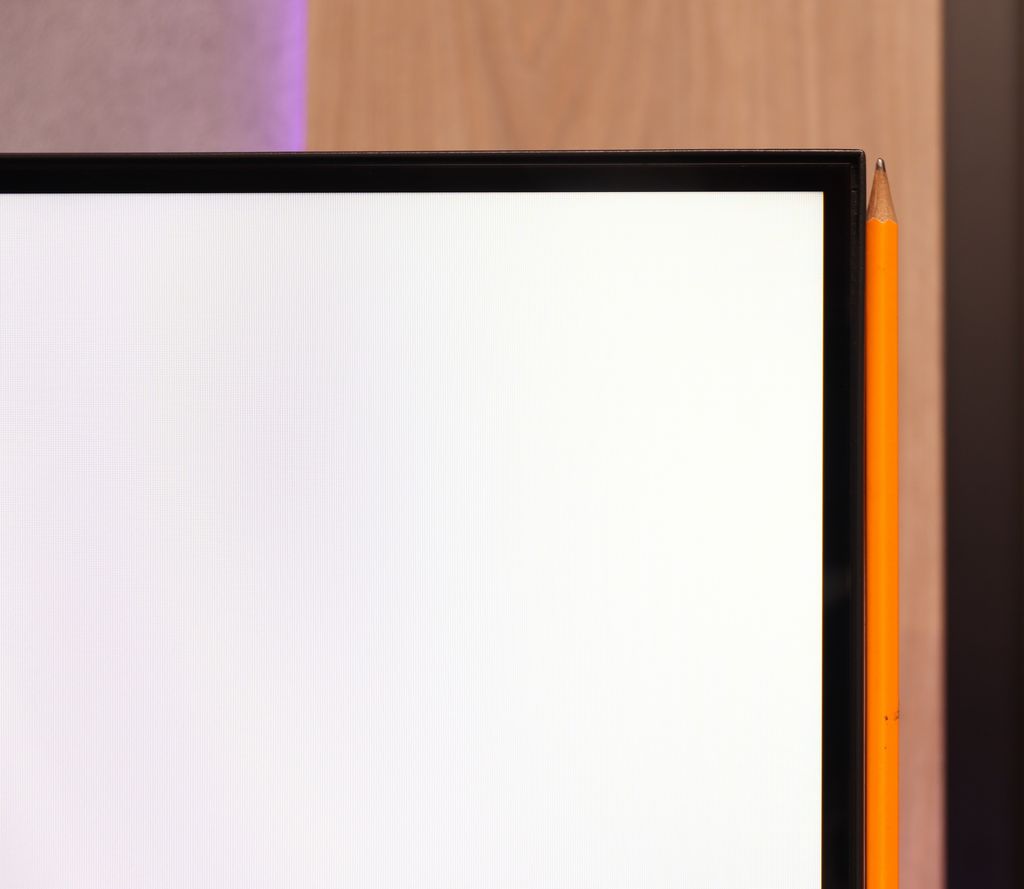

Contrast and black detail
10/10
8/10
Local dimming function: Yes, number of zones: 560 (20 x 28)
Contrast:

Result
∞:1

Result
∞:1

Result
∞:1

Result
∞:1

Result
∞:1

Result
340,000:1

Result
62,850:1

Result
42,000:1

Result
11,100:1

Result
7,500:1
Halo effect and black detail visibility:

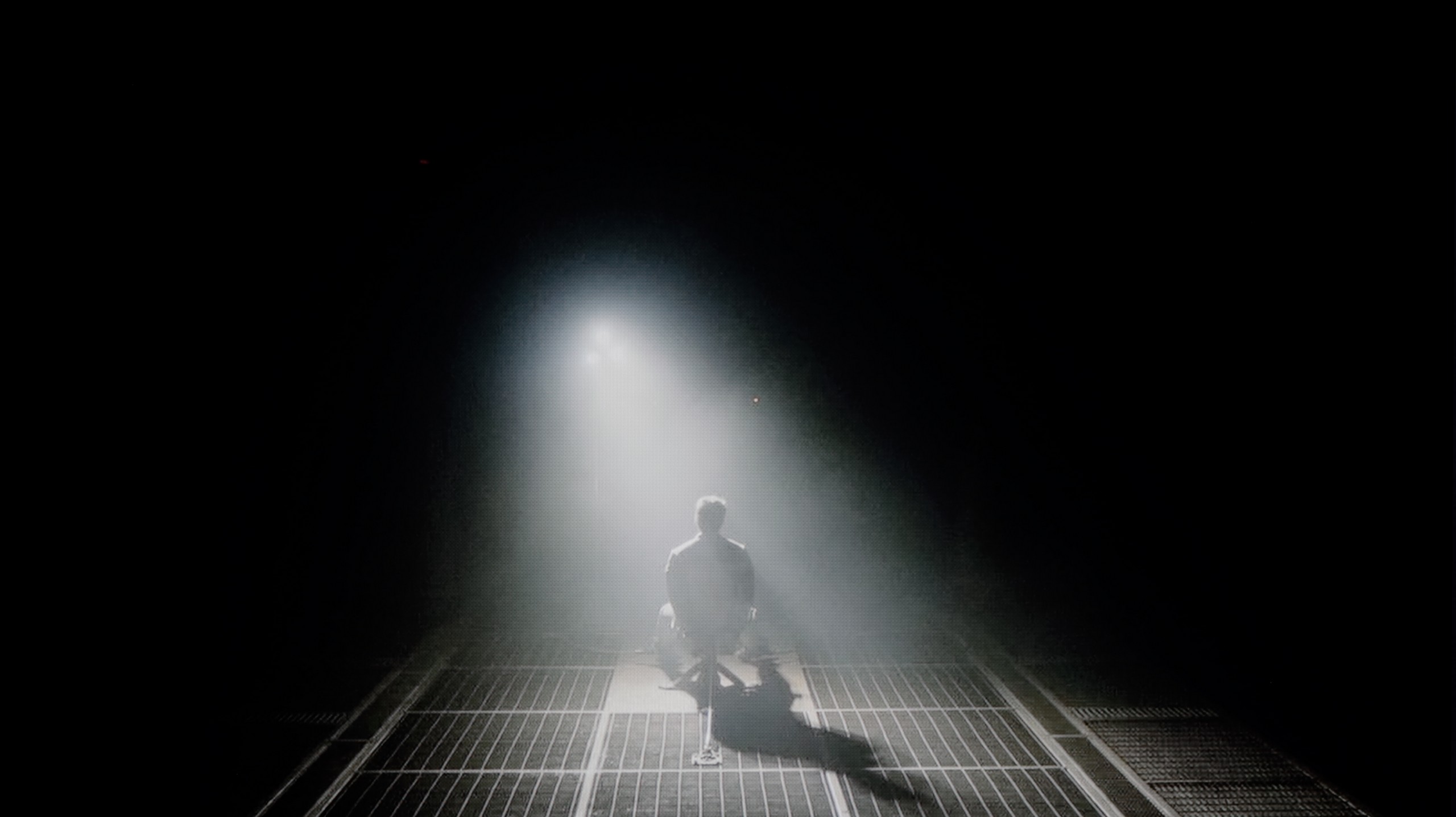
Philips OLED769 impresses with its black levels and contrast. Thanks to OLED technology, each pixel in this television is self-illuminating, allowing for the complete shutdown of individual pixels. This means that black areas of the image are pitch black, and the contrast is infinite. The effect is incredibly realistic, with excellent clarity and detail in dark scenes. The OLED panel used in Philips OLED769 is produced by LG, known as WOLED, ensuring the highest quality in black reproduction. As a result, the television offers a contrast that is unattainable for traditional LCD televisions - even the best ones on the market.
Hisense U7Q PRO is a mini-LED television with a VA panel and – in the 65-inch version we tested – 560 local dimming zones. It's worth noting from the outset that this number varies depending on the size – larger screens will have more zones, while smaller ones will have fewer accordingly. However, regardless of this, the dimming system works really well here.
The contrast performs exceptionally well for the price range in which this model sits. In optimal conditions, the U7Q PRO can achieve results close to six-figure values, which not long ago was reserved for equipment at a much higher level. In practice – in scenes like the one from the film Oblivion – the image looks stunning. With slightly dimmed light in the room, it can be difficult at first glance to distinguish this television from organic screens. Of course, it is still an LCD with local dimming, so compromises are unavoidable. In more demanding scenes, where there are many small light sources, the U7Q PRO tends to dim too aggressively. Instead of a slight deterioration in black levels – some details that should be visible disappear. This is a side effect of the algorithm that strongly adheres to the rule of "black should be black," even at the cost of subtle image elements.
But nevertheless – contrast is one of the stronger points of this model.
HDR effect quality
6/10
6/10
Luminance measurements in HDR:

Result
609 nit

Result
707 nit

Result
801 nit

Result
775 nit

Result
261 nit

Result
1129 nit

Result
323 nit

Result
721 nit

Result
267 nit

Result
736 nit
Scene from the movie “Pan” (about 2800 nits)


Scene from the movie “Billy Lynn” (about 1100 nits)


Static HDR10


Dynamic: Dolby Vision
Dynamic: Dolby Vision


HDR luminance chart:
Hisense U7Q PRO
Luminancja HDR
Luminance of RGB colors
Philips OLED769
Luminancja HDR
Luminance of RGB colors
Philips OLED769 performs quite well, particularly in film scenes with small points of light. The television surprises with its brightness, reaching around 800 nits, which is an impressive result. As a result, fine sources of light, such as street lamps at night or stars in the sky, are sharp and full of detail. However, the biggest challenge for this model is the scene with a full-screen burst of sunlight. In such moments, the brightness drops to about 250 nits, which is not very impressive. This is a typical problem for cheaper OLED displays, which struggle to maintain high brightness across the entire screen surface.
U7Q PRO is truly a bright television. In synthetic tests, it achieved over 1500 nits, which is an outstanding result for this price range. Such brightness – at least in theory – allows for HDR content to be displayed as intended by the creators, even in more demanding scenes with strong lighting. In practice, it is often very good, but not always perfect. In bright scenes with large areas – like the test chart with intense sunlight from the movie "Pan" – the U7Q PRO makes a huge impression. It can almost dazzle with its brightness, which is definitely an advantage in the context of HDR content. Unfortunately, it doesn't always manage to maintain this when many small bright details appear on a dark background. In such moments, the local dimming algorithms choose to dim some bright elements to maintain good black levels – and the side effect is that some details simply disappear from the frame. This is a classic compromise in mini-LED televisions – and the U7Q PRO is no exception. However, with such a large number of dimming zones, one could have hoped for a slightly more mature algorithm responsible for their control. Fortunately, the overall perception of HDR content is decidedly positive. The U7Q PRO is not only bright but also colourful, thanks to the PFS LED (QLED) coating, the coverage of the DCI-P3 colour palette is at 95%, while BT.2020 is around 73%.
Factory color reproduction
6.4/10
6.2/10


Factory Mode
After calibration


Factory Mode
After calibration
The "Film" mode proved to be the best factory setting in terms of fidelity to the source material, and it is on this that we based our tests. However, like other factory modes, it was not without flaws. Let us examine, therefore, what exactly went wrong in SDR and HDR materials.
In both cases, the white balance was disrupted by the excessive dominance of green and red hues. This phenomenon created a yellowish tint that spread across the entire image, leading to issues such as yellowed whites and unnatural skin tones. These problems were clearly highlighted on the "ColourChecker" palette, where each of the samples was shifted towards warmer tones.
As for contrast and brightness, in the Philips OLED769, we can look at two key graphs: Gamma for HD content and the EOTF curve for 4K HDR content. In the case of the first graph, the gamma value falls below the optimal level of 2.4, resulting in an increase in brightness of light areas of the image. This means that bright elements may be slightly overexposed, losing detail and depth. In contrast, the EOTF curve for 4K HDR content performs really well. The graph shows that the television effectively conveys details in both the brightest and darkest areas of the image, resulting in a realistic and dynamic representation of scenes.
We tested the U7Q PRO in the best possible picture mode offered by this model – Filmmaker Mode. And indeed, this mode performs the best in terms of colour reproduction. However, that doesn't mean it's perfect. In our test unit, both in SDR and HDR content, the image had a slightly cooler tone. The white balance was skewed towards blue, giving the overall impression of being a bit "colder". It may not be glaring, but it is definitely noticeable – especially on white backgrounds, which seemed slightly bluish rather than neutral. Additionally – as we mentioned earlier – the television has a tendency to slightly brighten and oversaturate the image, which is also confirmed by the gamma and EOTF graphs. All this together means that without calibration, the image can appear somewhat unnatural – too cool, with slightly exaggerated dynamics. Therefore, we decided to carry out our own calibration – and you can see its effects and graphs below.
Color reproduction after calibration
8.8/10
7.5/10




After professional calibration, Philips OLED769 truly shines in terms of colour accuracy. The television has been completely stripped of any yellow tint in both HD and 4K content. The Colour Checker test confirms that deltaE errors are minimal, occasionally exceeding a value of 2, which means we can speak of almost perfect director's representation.
When it comes to contrast, the situation is equally impressive. With 4K materials, there wasn't much to improve initially, while the gamma chart has been significantly enhanced. This allows dark and light areas of the image to be represented with greater accuracy, resulting in a realistic and dynamic portrayal of scenes.
The calibration has allowed the full potential of this television to be unleashed, both in terms of colours and contrast. Philips OLED769 now offers vivid, natural images of high quality that will delight any user, whether they are watching films or using other multimedia.
Thanks to the calibration, we managed to tame the white balance in SDR and HDR content. In the case of SDR materials, the effect is really very good – the image becomes neutral, cohesive, and simply pleasant to take in. Everything looks as it should.
HDR performs a bit worse. Although the white balance appears correct and the image overall gains in naturalness, unfortunately, the delta E errors remain noticeable. Why? Because Hisense does not give us full control over how the television manages brightness in HDR mode with the U7Q PRO model. This is where the limitation comes into play. When we look at the EOTF curve for HDR content, we can clearly see what we mentioned earlier – at the beginning of the graph, there is a distinct drop, meaning the television darkens the smallest areas more than it should. On the other hand – the brightest elements can sometimes be overly bright. As a result, some details get lost, others are too aggressive, and overall control over brightness does not always match what we are trying to achieve during calibration.
Does the image look better after calibration? Definitely yes, in terms of colour. But when it comes to managing brightness in HDR, we have to accept that the Hisense U7Q PRO will do it in its own way.
Smoothness of tonal transitions
5.9/10
9.5/10







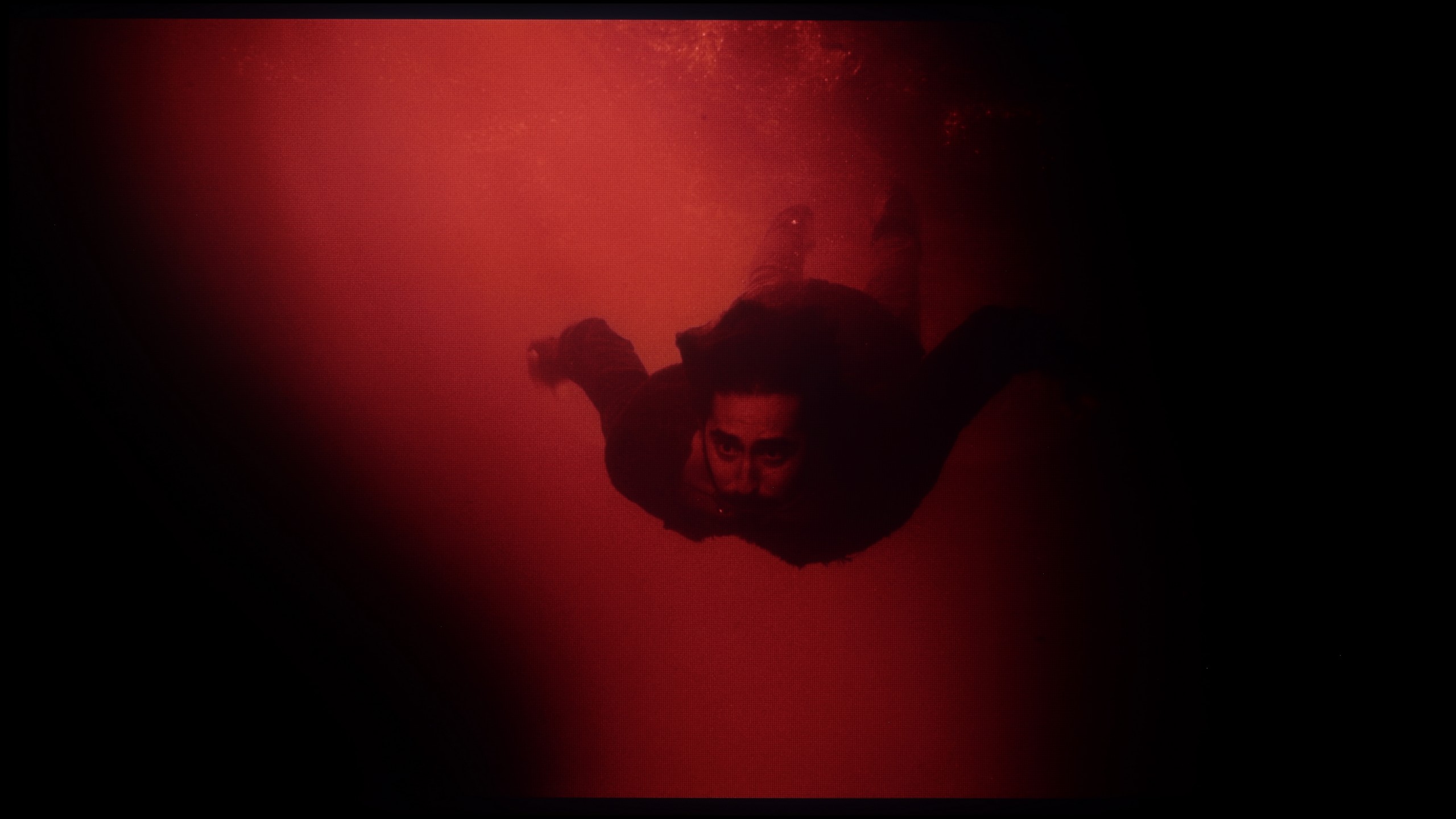




The gradation in Philips OLED769 unfortunately proves problematic in almost every scene from the test sequence. Particular difficulties arise in dark colours and around black. In these areas, in addition to the posterisation effect, the image is enhanced by a solid dose of noise. The problem with tonal transitions is not limited to dark hues – it can also be seen in lighter elements, such as in a scene from the film "Kingsman," where clear colour banding is visible around the sun. This phenomenon can significantly affect the visual perception, especially in scenes where black and dark shades play a key role. It's hard not to notice these imperfections, which can disrupt the viewing experience, particularly for viewers who value excellent image quality.
The U7Q PRO handles tonal transitions really well. Colours blend smoothly, without any banding, stripes or strange artefacts. Even in more challenging scenes that typically expose any imperfections – there was nothing to criticise here. The image simply looks clean. Gradients – both coloured and grey – are smooth, nothing tears, nothing distracts. This is one of those elements that you don’t pay attention to while watching… certainly not in the case of the U7Q PRO.
Image scaling and smoothness of tonal transitions
7.2/10
7/10
Smooth transition function

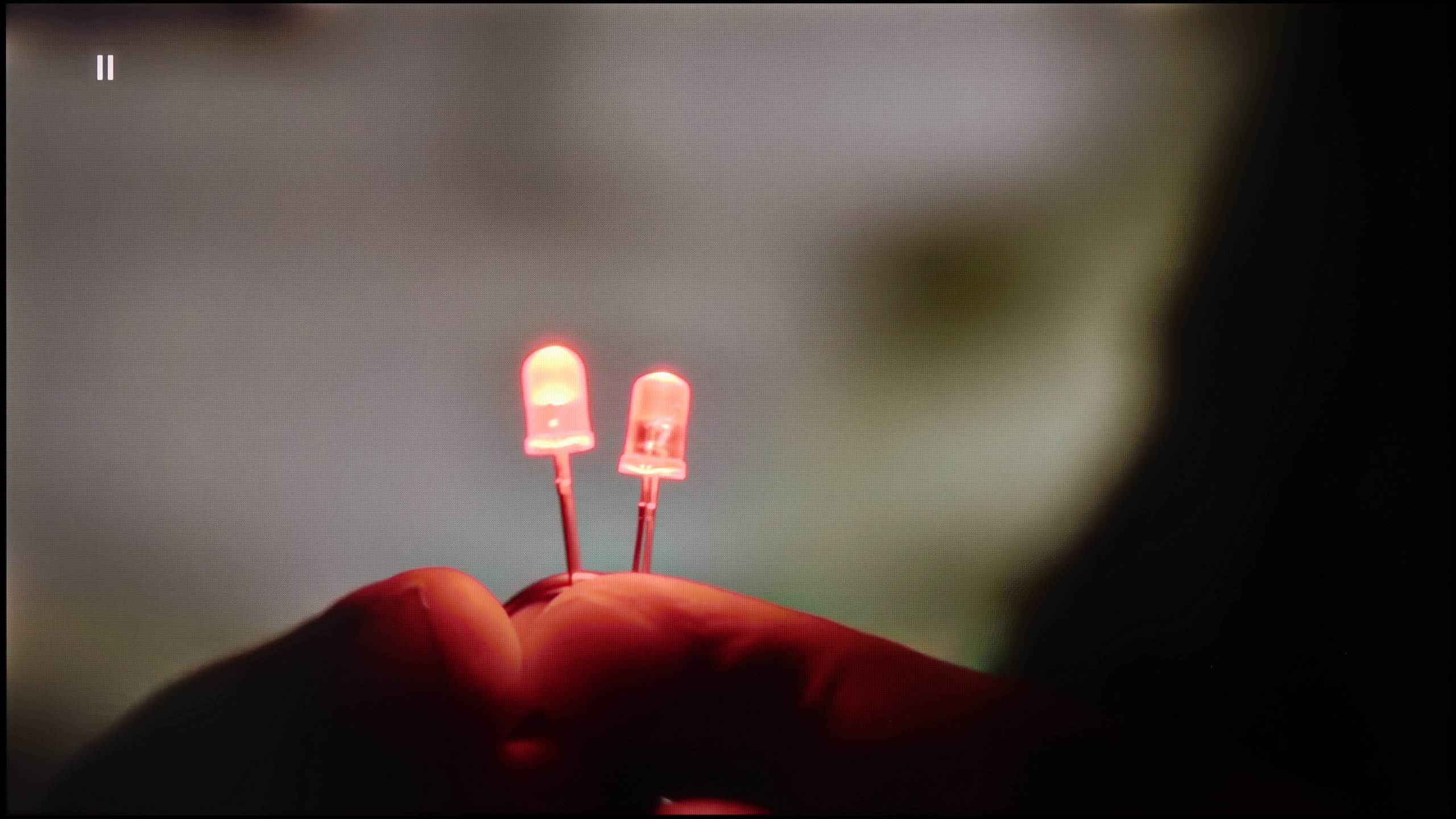
Image without overscan on the SD signal


When it comes to lower quality materials, the distortion reduction in the Philips OLED769 handles tonal transitions well, especially at the minimum setting. It is worth noting that at this setting, film grain is not blurred, which is a pleasant surprise, as such negative phenomena often occur with other manufacturers. Overall, it is quite a decent solution. However, it should be pointed out that this setting does not work in HDR mode, where gradation issues are much more pronounced. In HDR mode, the television struggles with smoothing tonal transitions and may present more noticeable distortions and noise, reducing picture quality in dynamic scenes.
Regarding digital processing, the Philips OLED769 performs well. The model in the photo is not overly jagged, and the branches in the background lack the characteristic jagged edges. The television achieves this effect thanks to the absence of artificial sharpness, which may be an advantage for some users. Others, however, may find this less attractive, as they prefer a more vibrant, sharper image instead of a subtle effect. This effect can be mitigated by using a higher setting for the "Sharpness" parameter.
If someone happens to come across older materials where the colour banding issue occurs – Hisense has a solution for that. In the U7Q PRO, we find a function called "Smooth and Gradient Image". Set to the "Medium" level, it works really well – removing most issues with gradation while not smoothing out the entire image, like blurring in Photoshop. 😉 Film grain remains, details do not disappear – this is exactly how it should work. Well done on the implementation!
As for upscaling weaker materials, it is simply good. It is not at the level of the most expensive televisions with advanced upscaling, but older content looks good. There is minor aliasing at very low resolutions, but this is completely normal and hard to avoid. On the plus side – even with the oldest materials, there is no overscan effect, the image is neither cropped nor artificially stretched.
Blur and motion smoothness
8.3/10
7.5/10

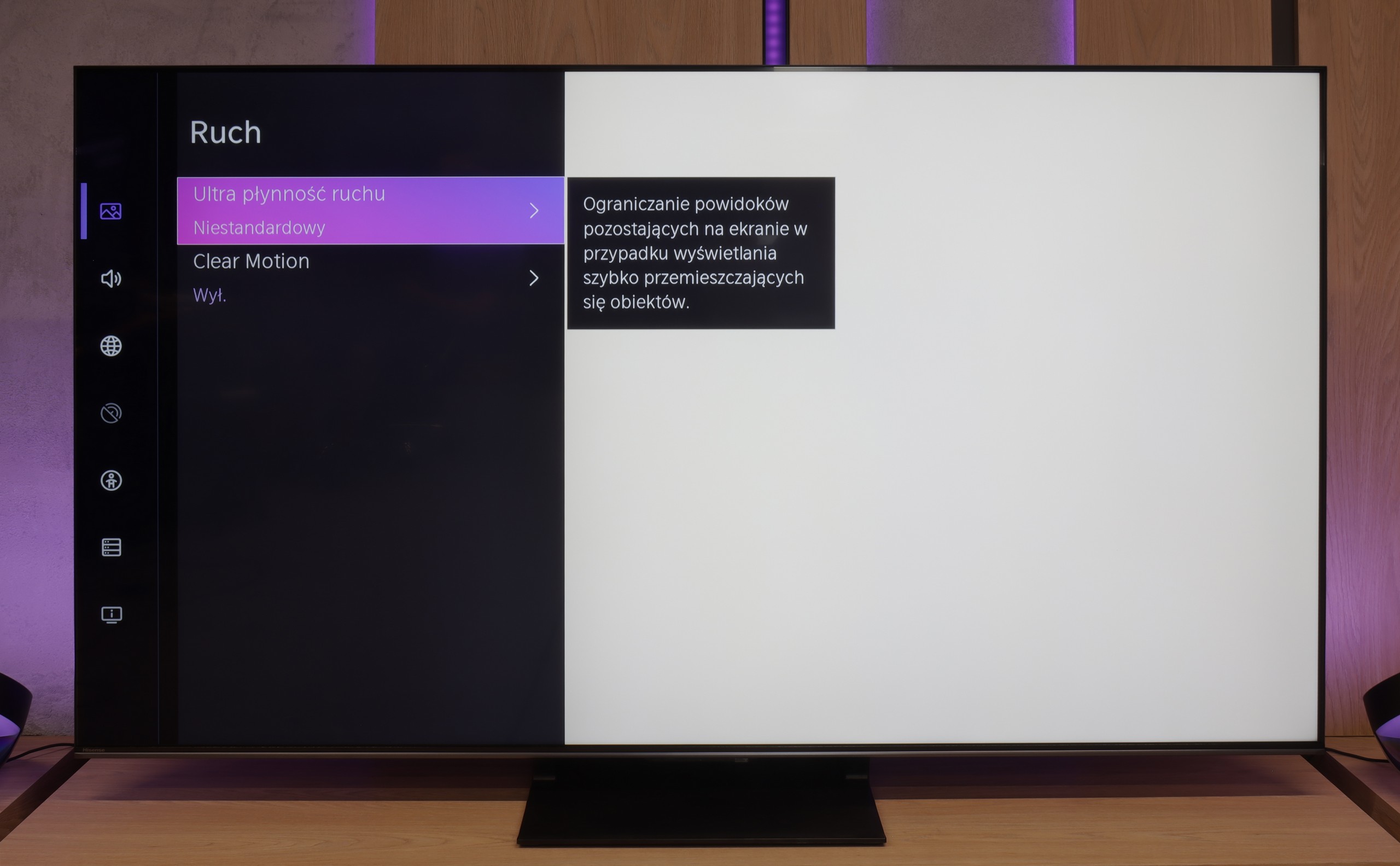
Blur (native resolution, maximum refresh rate):





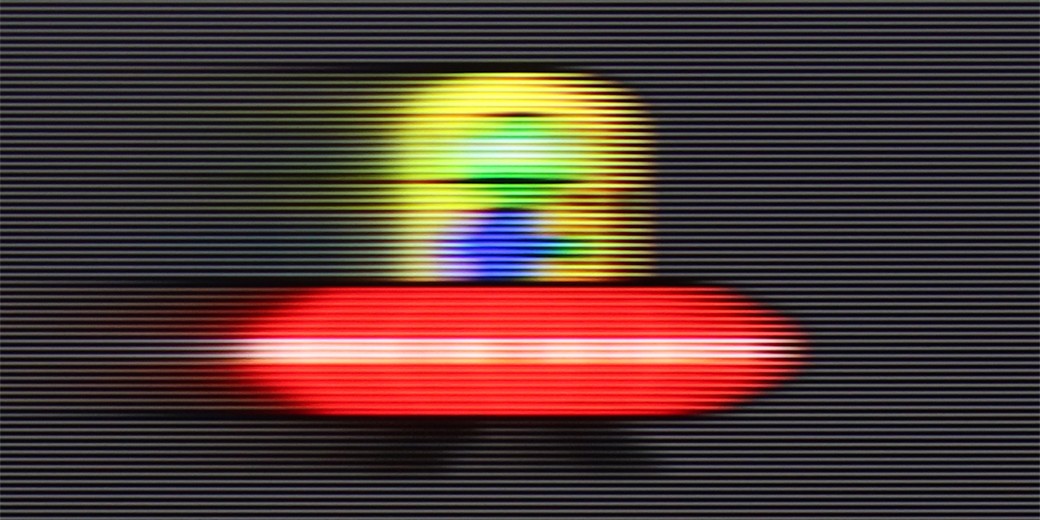
Blur (BFI function enabled):



Smużenie ():
Smużenie (1080p 288Hz):



Philips OLED769 features a multi-stage motion smoother called "Motion Style", which will satisfy users who appreciate the ability to customise the fluidity of motion in films. With this function, you can set the image to be more frame-like or smooth, resembling a theatrical effect. This is a great solution for those who want to adapt the displayed content to their visual preferences. Gamers will also not be disappointed, as the television, like most OLEDs, is equipped with a 120Hz panel. This provides exceptional fluidity and dynamism of the image. Unfortunately, Philips OLED769 does not have the BFI (Black Frame Insertion) feature, which could further improve motion fluidity and sharpness. Despite this limitation, the television still offers excellent visual experiences for both cinema lovers and gamers. This is definitely one of its strong points.
“Speed” – this word came up most often during our tests of the U7Q PRO. The television is equipped with a 165 Hz panel, which is impressive in itself – especially since we are talking about a model in the mid-range price category. Of course, PC gamers will benefit the most from its full capabilities, but even with everyday viewing, it's clear that this is a fast and efficient panel. Like most modern televisions, the U7Q PRO can also enhance the fluidity of films that were originally recorded at 24 frames. In the menu, we find a slider that allows us to adjust the effect to our own preferences – from a more cinematic look, with subtle motion, to stronger smoothing with the characteristic “telenovela effect.”
Console compatibility and gaming features
10/10
8.5/10
- ALLM
- VRR
- VRR range40 - 120Hz48 - 288Hz
- Dolby Vision Game Mode
- Correct implementation of HGIG
- 1080p@120Hz
- 1440p@120Hz
- 4K@120Hz
- Game bar

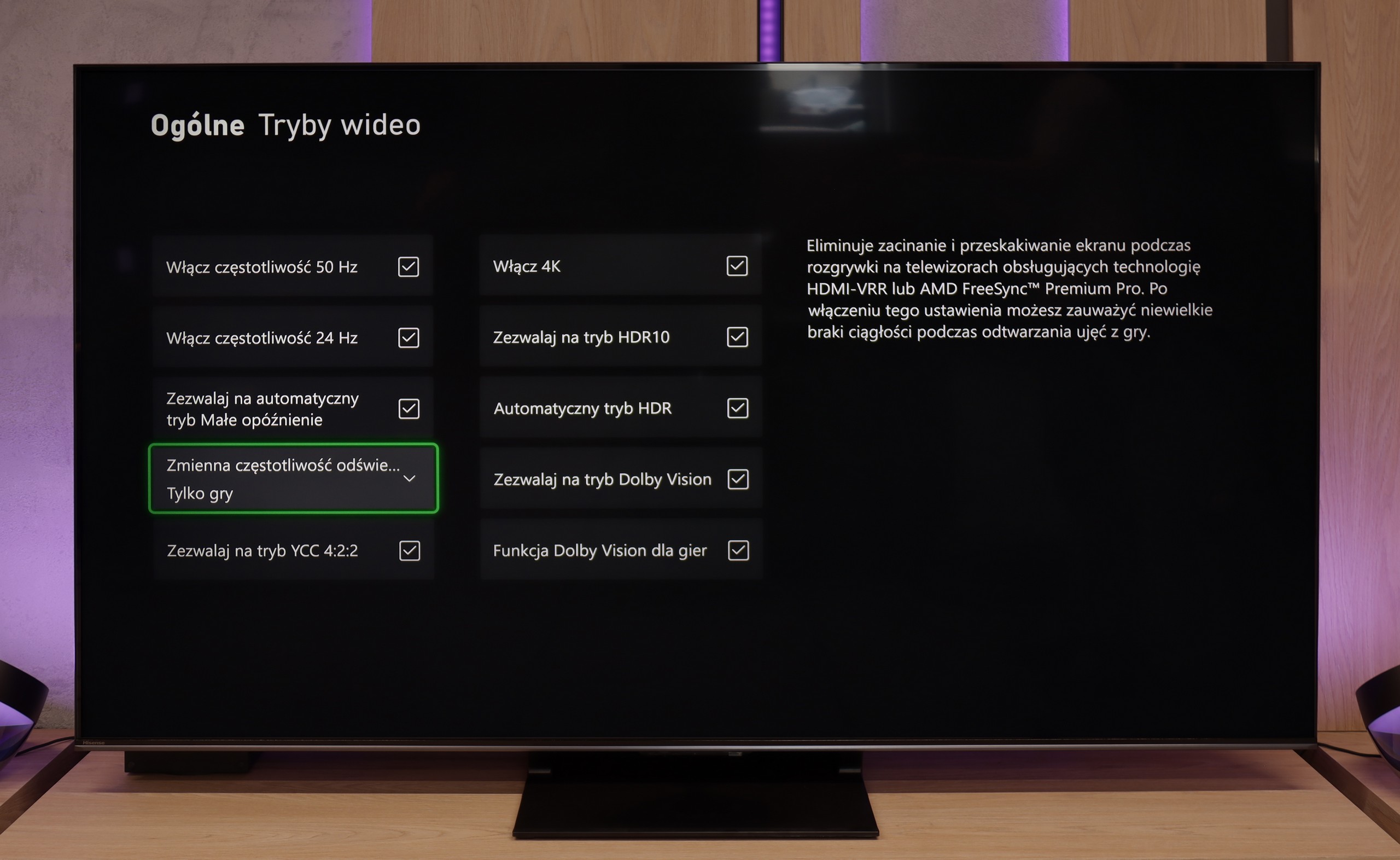



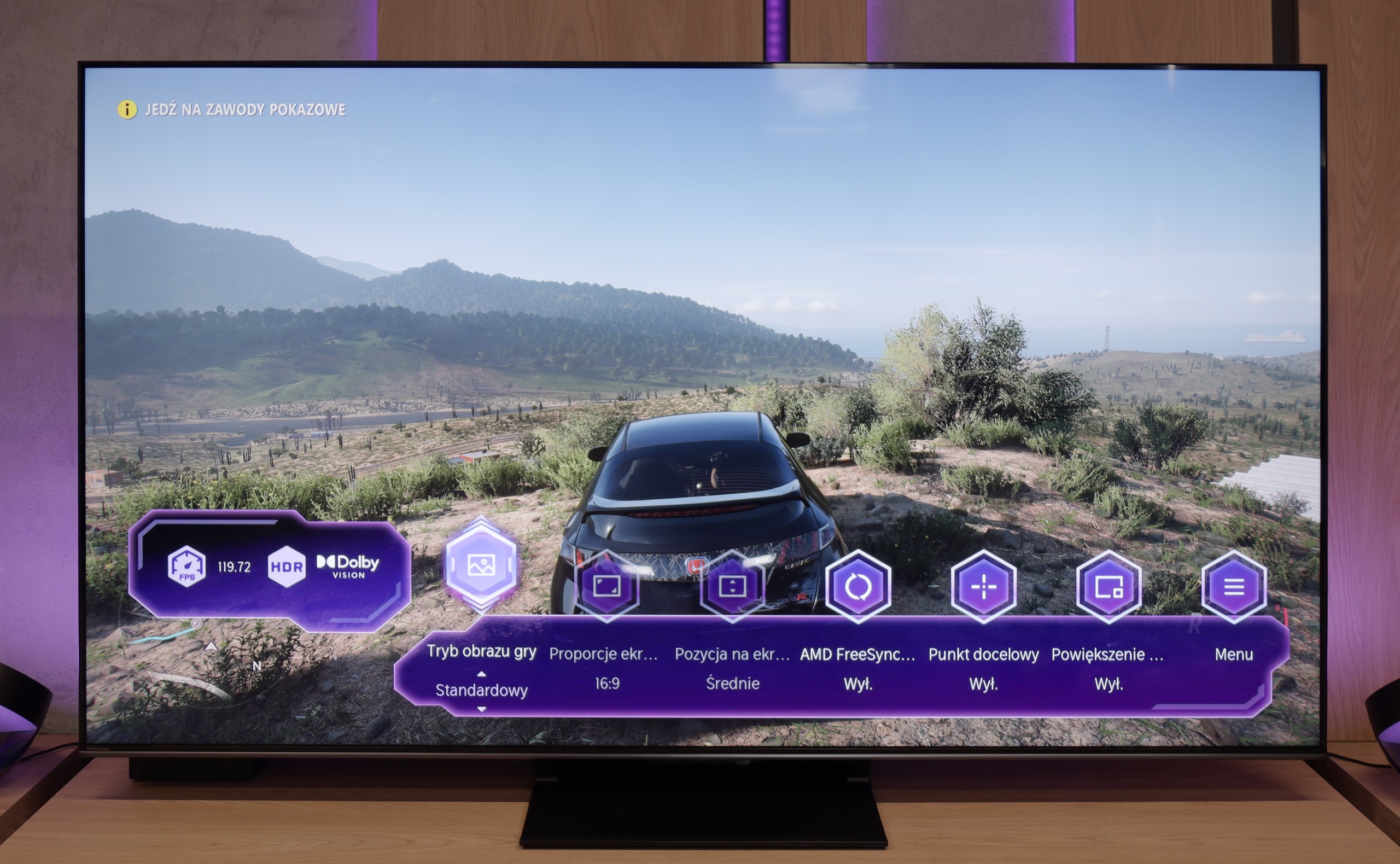

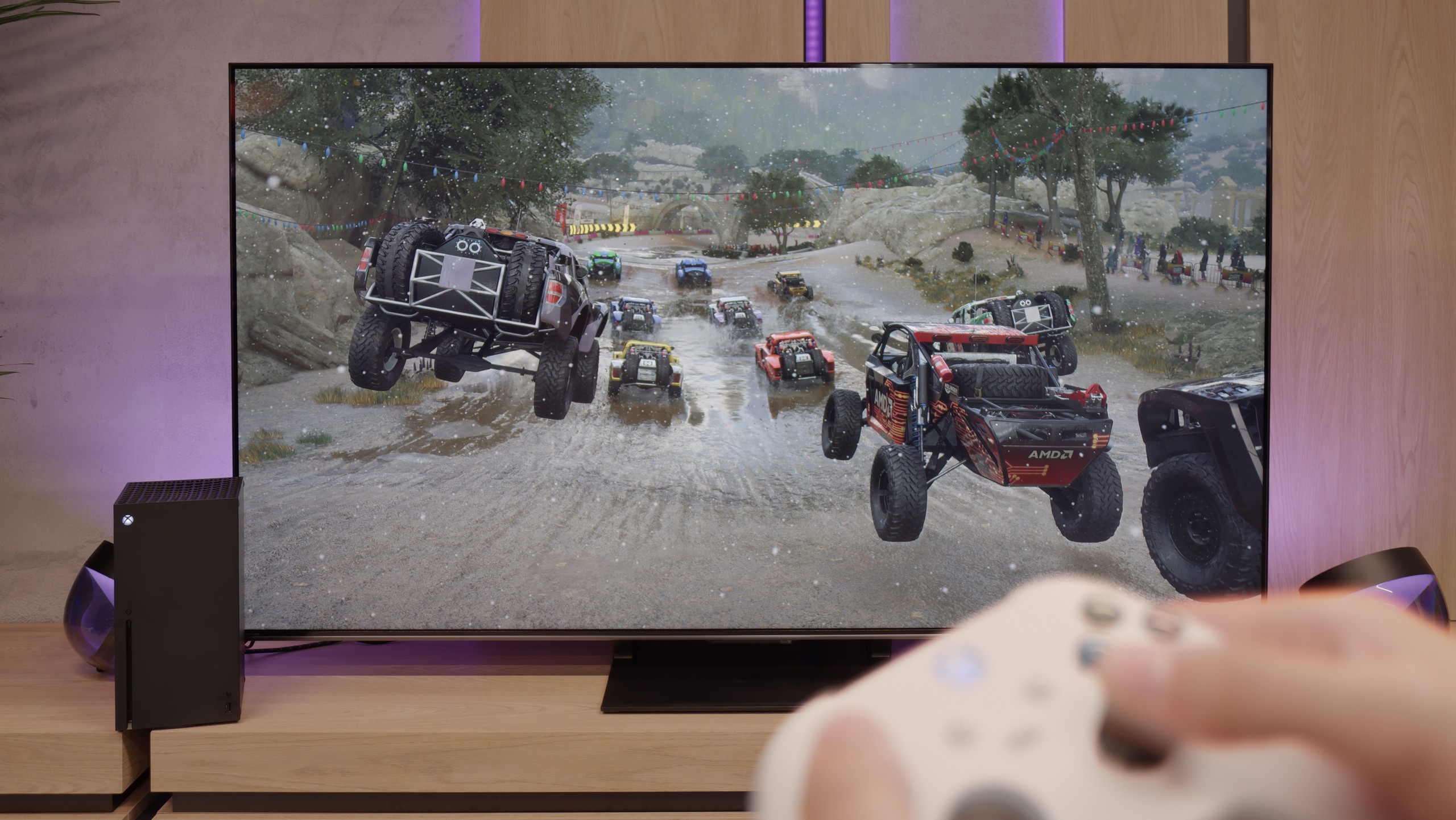
Philips OLED769 has been designed with gamers in mind, offering full compatibility with consoles and the highest quality of gameplay. The television received the maximum rating in this category, providing everything that the heart desires. With HDMI 2.1 ports fully supporting ALLM (Auto Low Latency Mode) and VRR (Variable Refresh Rate), the television ensures smooth and hassle-free gaming. ALLM automatically switches the television to low latency mode, while VRR eliminates stuttering and screen tearing, resulting in fluidity and stability in gaming. The Dolby Vision gaming feature is another advantage, although it only works at a frequency of 60 Hz. Most casual gamers will likely not feel the lack of a higher frequency; however, more demanding users may have some reservations. This allows for enjoyment of a dynamic range of tones and realistic images, enhancing the gaming experience. PC gamers will also not be disappointed, as Philips OLED769 offers full compatibility with Nvidia graphics cards, thanks to support for G-Sync. This technology synchronises the refresh rate of the television with the graphics card, eliminating tearing and stuttering, resulting in excellent image fluidity.
Philips OLED769 is a television that perfectly meets the needs of gamers, offering a wide range of advanced features and technologies that significantly enhance gameplay quality and user comfort.
The Hisense U7Q PRO is a television that seems almost designed with gamers in mind. It has practically everything one could expect from a gaming display: variable refresh rate (VRR), automatic low latency mode (ALLM), and as many as four HDMI 2.1b ports with full bandwidth of 48 Gb/s. Additionally, there is a clear and quite functional Game Bar, as well as a well-implemented Dolby Vision GAMING mode that works seamlessly with Xbox Series S and X consoles.
Sounds like perfection? Well, almost. Unfortunately, Hisense has still not implemented the HGiG feature, which means the system limitation of tone mapping on the television side. This means that when configuring HDR brightness on the console, we do it "by eye" or search for settings in online guides, as the display does not show the actual range of its brightness. It’s a pity – because HGiG indeed makes it easier to match the console to the television and helps avoid overexposure or overly dark scenes in HDR games.
Fortunately, the other features work very well. Input lag is low, responsiveness is excellent, and the handling of other functions is impeccable. And while not everything worked perfectly, the U7Q PRO can still be recommended to gamers without hesitation.
Input lag
9.8/10
9.8/10
SDR
HDR
Dolby Vision
The input lag on the Philips OLED769 is truly impressively low. At a frequency of 120Hz, values hovering around 5 ms make a huge impression, and for a frequency of 60Hz, 13 ms is also an excellent result. Such low latencies ensure a quick response to player movements, which is crucial for smooth and responsive gameplay. The only thing that can be criticised is the lack of support for Dolby Vision at materials/games with a refresh rate of 120Hz. Nevertheless, the television still offers incredible visual experiences and excellent specifications that will satisfy any gamer.
In terms of signal latency, the Hisense U7Q PRO performs really well. For 120 Hz content, the input lag remains below 10 ms, which translates to a lightning-fast response – the screen almost instantly reacts to our movements, something console and PC gamers will particularly appreciate. With 60 Hz content, the situation is somewhat worse, as the response time doubles – this is natural and applies to virtually all televisions. Nevertheless, it still remains below 20 ms, which can be confidently considered a very good result, even close to perfection – and in practice, it is hardly noticeable during gaming.
Compatibility with PC
7.6/10
8.2/10

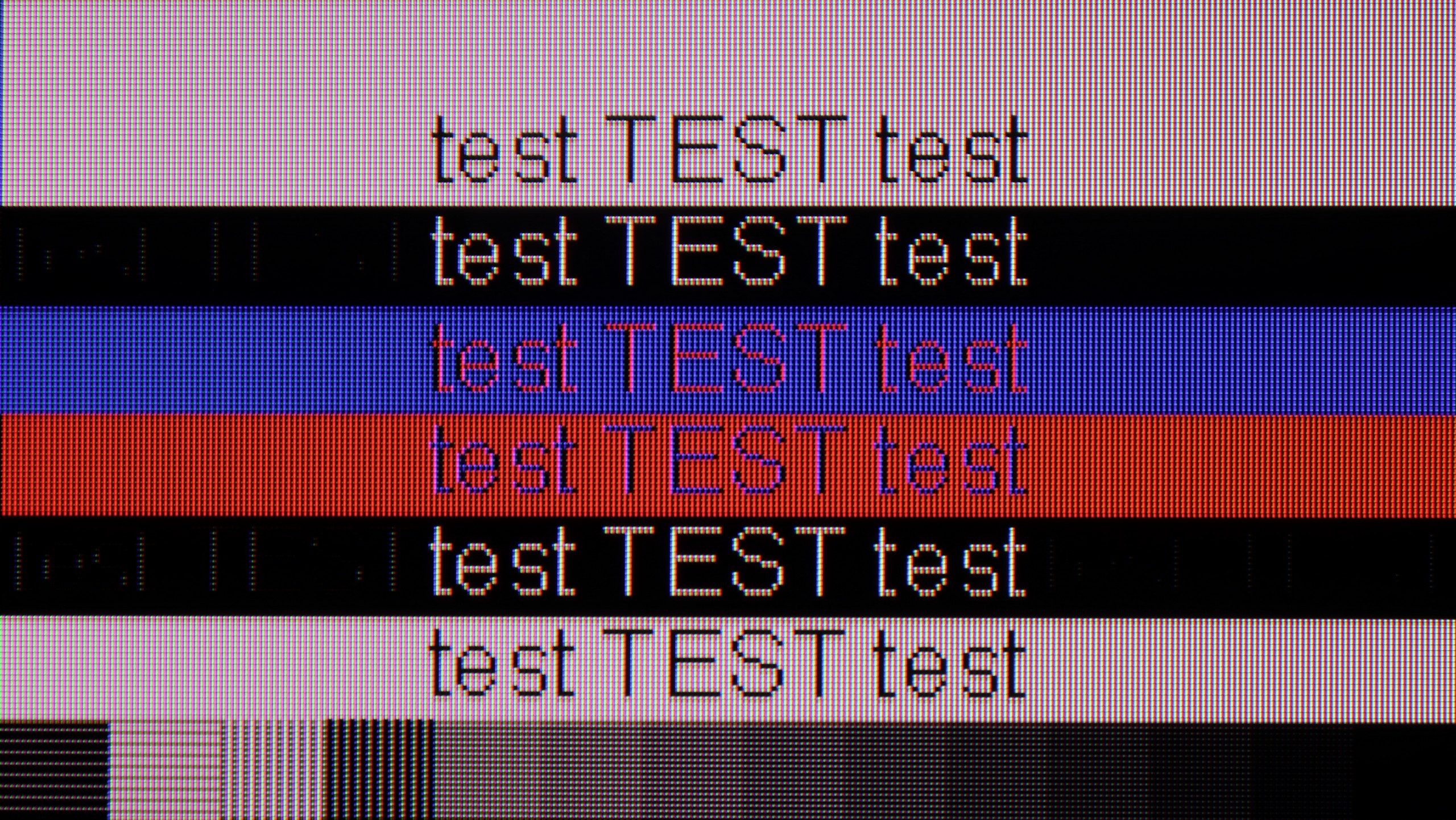
OLED769 performs excellently in collaboration with PCs. The rating in this category is very good, primarily due to the great readability of fonts, regardless of the background colour. The support for chroma 4:4:4 further enhances image quality, ensuring clear and sharp details. The low response time is another advantage of this model, which translates into smoothness and responsiveness during work and gaming. All of this makes the Philips OLED769 an ideal choice for PC users seeking a large screen with high image quality and excellent parameters.
Playing on PC using the Hisense U7Q PRO is pure fun. Low input lag, full 165 Hz in 4K and even 288 Hz in Full HD - these are numbers we wouldn’t expect from a television at this price. In this regard, it’s really hard to fault anything. If someone is looking for a large screen for gaming from a PC - the U7Q PRO can confidently serve as a monitor. It performs slightly worse for everyday work with text. Although chroma 4:4:4 is present, so theoretically everything should look good. But in practice, grey fonts on a dark background look strange – vertical lines are sharp, but horizontal ones can blur, disappear, or appear slightly dimmed. However, it must be honestly added that if you use the television as usual – that is, from a few metres away – you probably won’t notice this. The problem only becomes visible when someone places the U7Q PRO on a desk, a metre from their face, and starts working with text or spreadsheets. If you plan to use it in that way – it’s worth keeping this in mind.
Viewing angles
7.5/10
3/10
When it comes to viewing angles, Philips OLED769 performs excellently, as is the case with all OLED televisions. The image remains clear and does not lose quality regardless of the viewing angle. This means you can enjoy exceptional picture quality even when watching from the side or from more unusual locations in the room. The only televisions that offer even better viewing angles are those equipped with QD-OLED and OLED MLA panels. These technologies can provide even greater stability and image clarity from various angles. However, compared to standard LCD televisions, Philips OLED769 still offers significantly better viewing angles, making it a great choice for large rooms and family movie nights.
In this regard, the U7Q PRO performs moderately. The television is equipped with a VA panel, which inherently is not known for wide viewing angles. When we start looking at the screen at an angle, the image noticeably loses brightness, and the colours begin to wash out. This is a completely normal phenomenon in VA panels without additional coatings that widen the angles – so if you plan to watch from the side or in a larger group, it’s worth keeping this in mind. On the other hand, directly in front – the image looks great, with deep blacks and very good contrast, much better than on IPS/ADS type panels.
TV efficiency during daytime
4.6/10
6.2/10




Matrix brightness
Average luminance SDR
Hisense U7Q PRO: 472 cd/m2
Philips OLED769: 258 cd/m2
The performance of the television Philips OLED769 during the day leaves something to be desired. The screen, although satin, moderately suppresses reflections, which can be noticeable in bright rooms. The low rating is primarily due to the rather average brightness of the television—250 nits is not impressive and may not be sufficient to ensure proper image quality in strong daylight. This makes viewing on sunny days potentially less comfortable, and the image details may be harder to discern.
As we mentioned earlier – the U7Q PRO is really a bright television, especially when it comes to HDR content. For SDR material, the television dims a bit, but an average brightness of around 500 nits is still a very solid result. This means that it's easy to watch television or movies even in quite a bright room. Only in very extreme lighting conditions – for example, strong sunlight directly on the screen – can visibility be somewhat affected. Fortunately, Hisense has applied a satin anti-reflective coating that effectively suppresses reflections, and the blacks retain their depth even during the day. This makes a difference and allows for comfortable use of the television in various lighting conditions.
Details about the matrix
Subpixel Structure:

Panel uniformity:

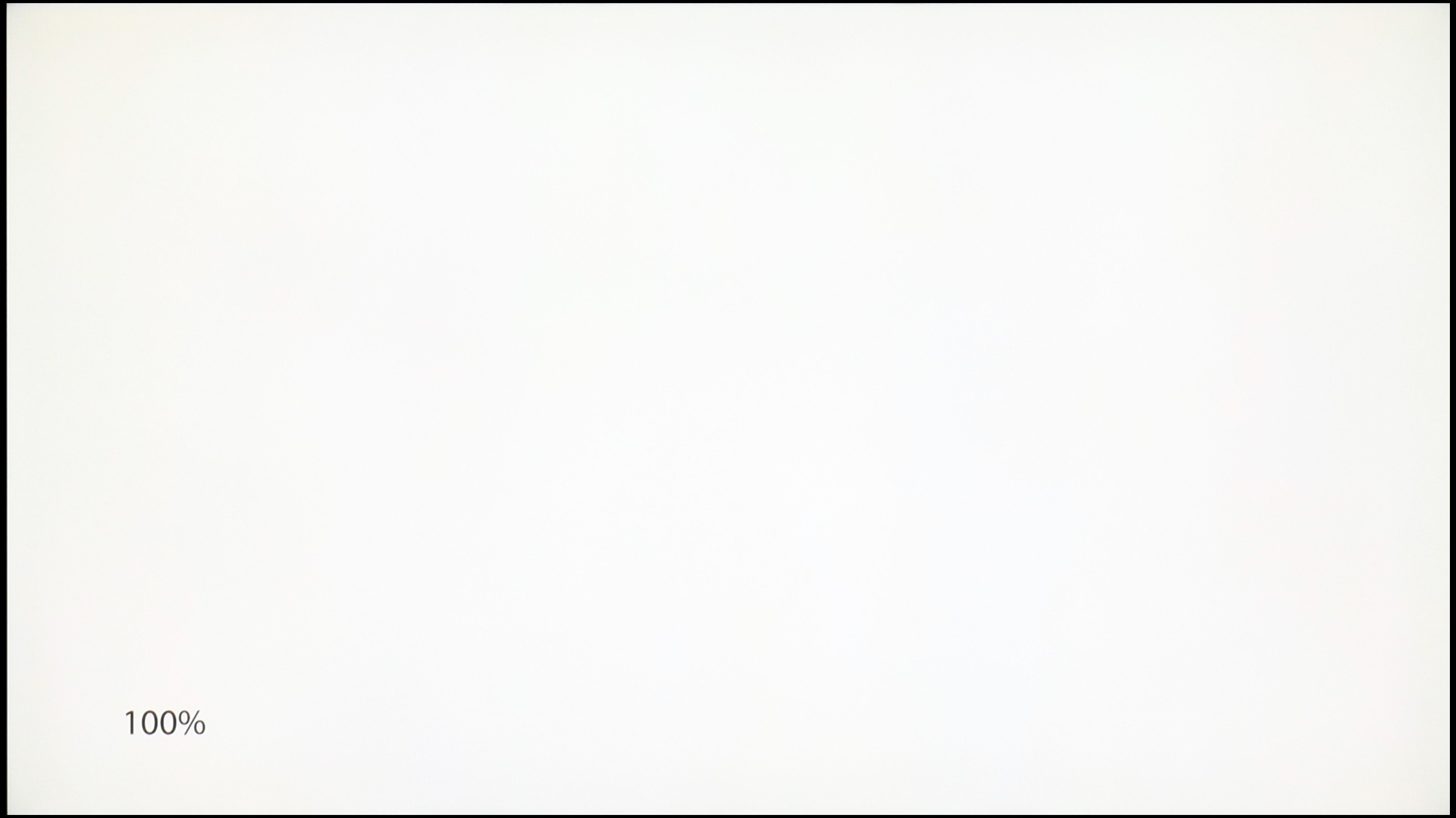
Philips OLED769
Hisense U7Q PRO
TV features
5.6/10
9.4/10
- HDMI inputs0 x HDMI 2.0, 4 x HDMI 2.1 48Gbps0 x HDMI 2.0, 4 x HDMI 2.1 48Gbps
- Other inputsRCA (Chinch)
- OutputsToslink (Optical audio), eARC (HDMI), ARC (HDMI), Mini-Jack (Headphones)Toslink (Optical audio), eARC (HDMI), ARC (HDMI), Mini-Jack (Headphones)
- Network InterfacesWi-Fi 2.4GHz, Wi-Fi 5GHz, Ethernet (LAN) 100MbpsWi-Fi 2.4GHz, Wi-Fi 5GHz, Ethernet (LAN) 100Mbps
- TV receptionDVB-T, DVB-T2, DVB-S, DVB-S2, DVB-CDVB-T, DVB-T2, DVB-S, DVB-S2, DVB-C
Classic features:
- Recording to USB (terrestrial TV)
- Recording programming
- Picture in Picture (PiP)
- RF remote control (no need to aim at the screen)
- Backlit remote control
- Teletext
- Audio only mode
- Possibility to connect Bluetooth headphones to the TV
- Possibility to simultaneously use Bluetooth headphones and the TV speaker
Smart features:
- AirPlay
- Screen mirroring (Windows Miracast)
- Wyszukiwanie głosowe
- Voice search in native language
- Ability to connect a keyboard and mouse

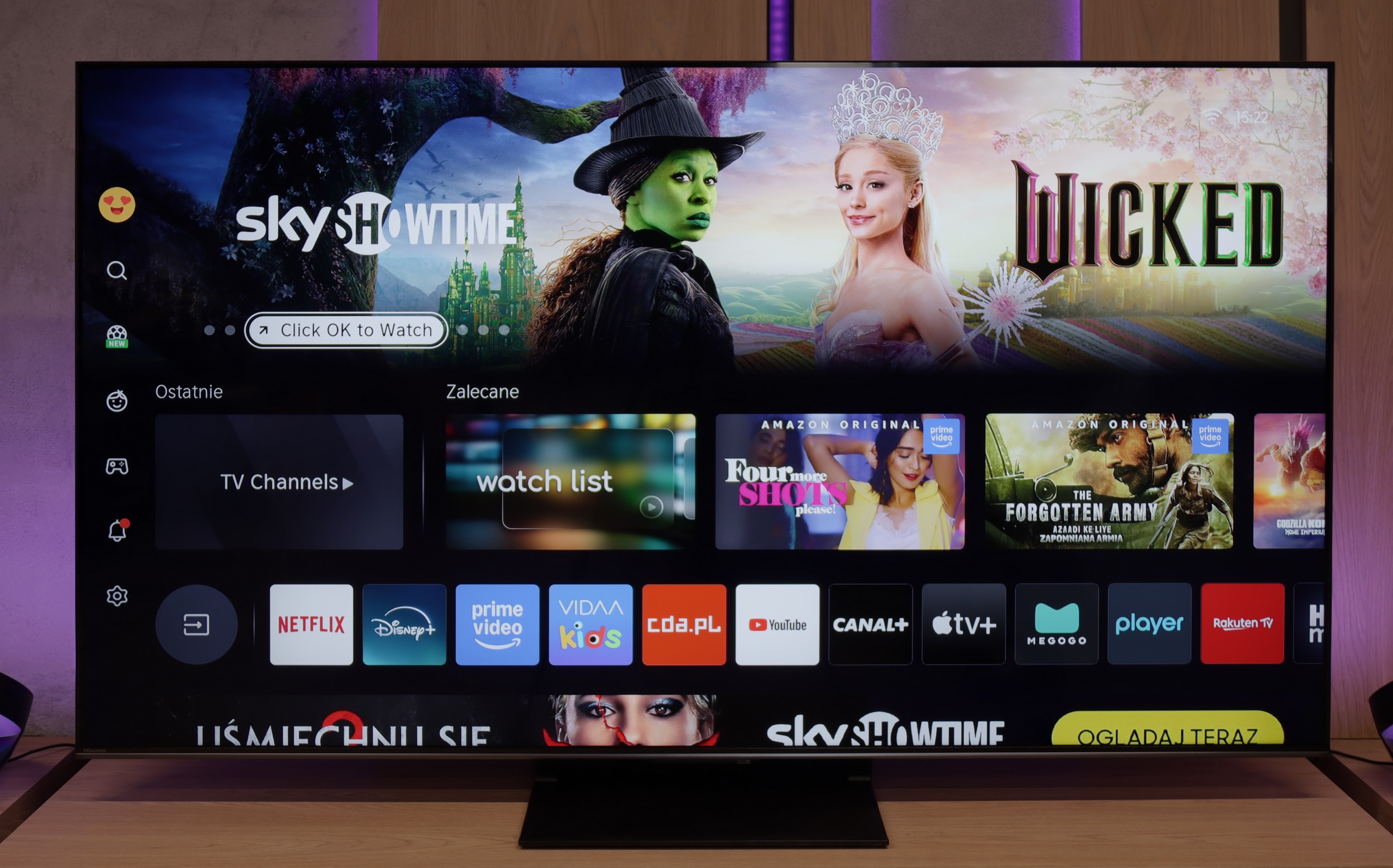
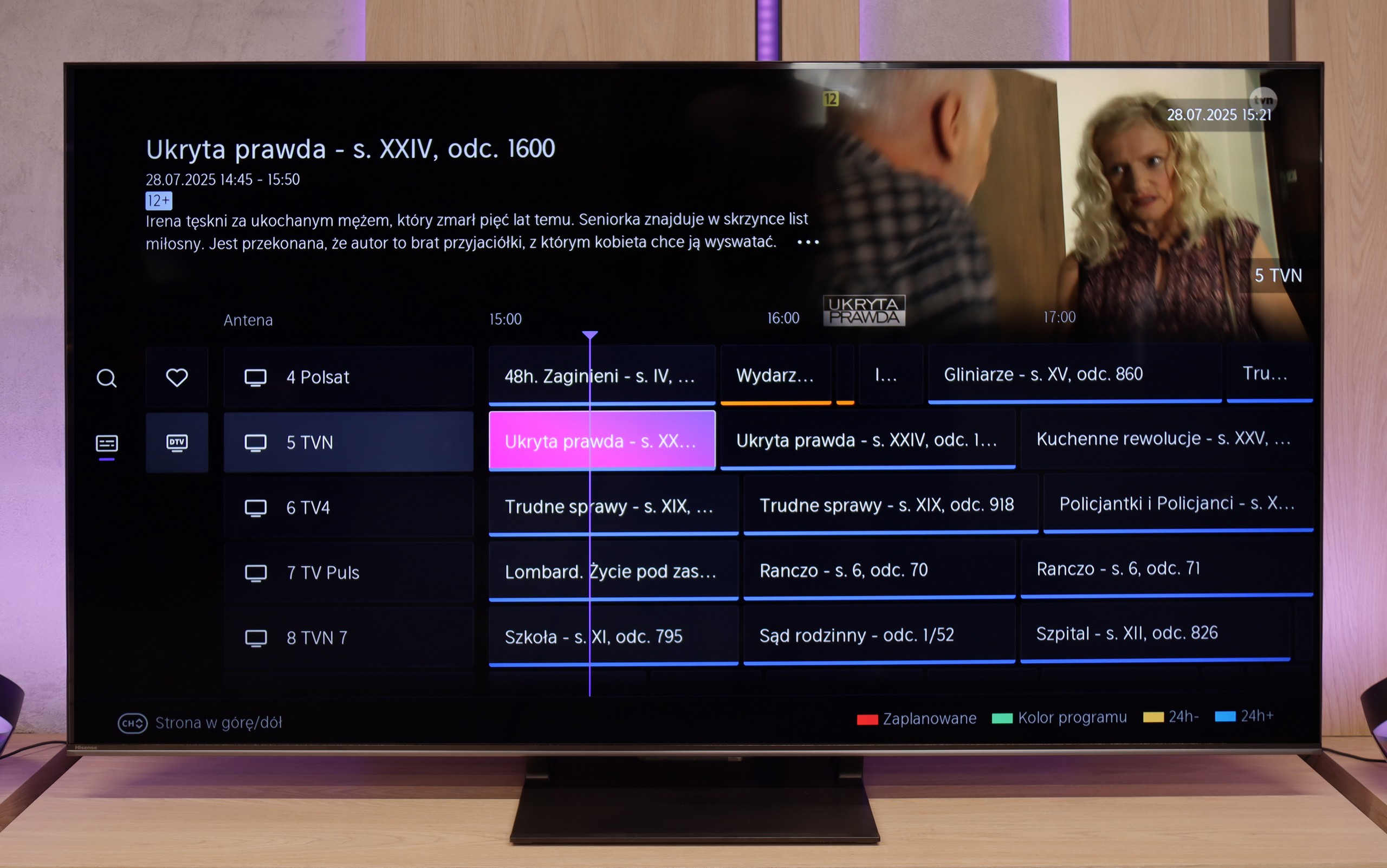
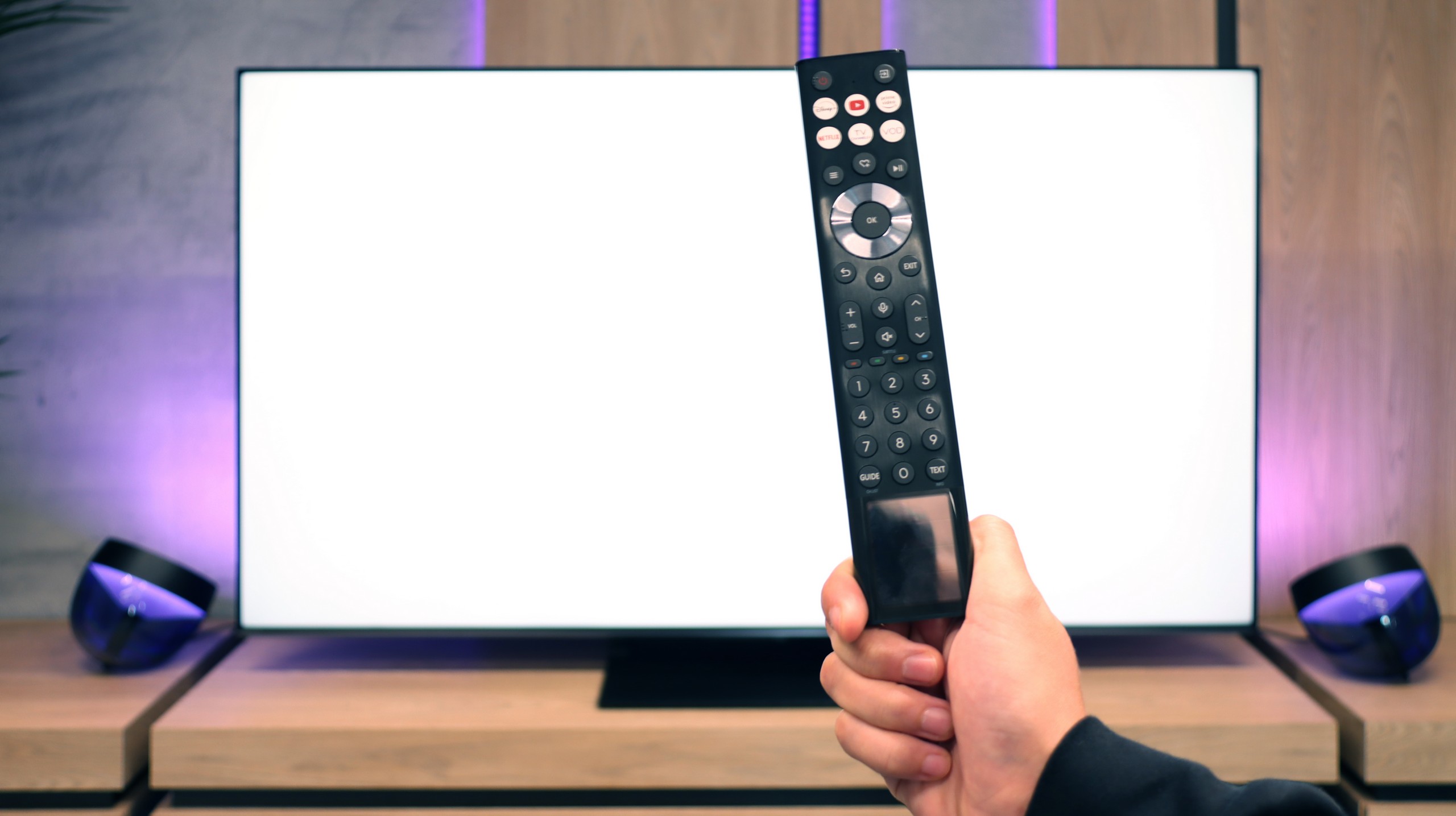

The greatest asset of the Philips OLED769 television is undoubtedly the three-sided Ambilight system. This technology truly makes a difference by extending the screen onto the walls around the television, creating the illusion of a larger screen. It not only enhances the visual experience but also adds a unique atmosphere, whether we are watching a film, playing games, or using other multimedia.
An interesting feature is the new remote control included with televisions operating on the TitanOS system. Its backlighting makes it very convenient to use, although its wireless functionality leaves something to be desired. Its hybrid design sometimes requires you to aim at the television screen, while at other times you do not, depending on which button you are using, which can be somewhat annoying.
In the context of the operating system, Philips has introduced a new strategy this year by replacing the previous open GoogleTV system with its own proprietary TitanOS. As is often the case with new technologies, TitanOS has its growing pains. At the moment, it only offers a few basic applications, and the app store does not impress with its variety. This may disappoint some users who expect a wide range of available applications. Additionally, the lack of support for AirPlay features and the ability to record onto USB are further limitations that could be problematic.
Classic Features of U7Q PRO
If you plan to use the television in a more "classic" way, that is, for watching daily programs or connecting headphones, the Hisense U7Q PRO has almost everything you might expect. The television easily supports recording to USB, you can connect headphones via Bluetooth, and the remote control is backlit, which still isn't standard even in more expensive models. Although many people today forgo these classic features in favour of streaming applications, it's good to know that the U7Q PRO still does this properly and without compromises (apart from the lack of PiP functionality).
SmartTV System: Vidaa
When it comes to smart features, this model operates on the VIDAA system in Europe. The system runs smoothly, has a built-in web browser, supports voice control (also in Polish), and AirPlay, which will delight users of Apple devices. However, it's worth noting that VIDAA is a closed system, so you won't find all the popular applications that we have gotten used to with Android TV or Google TV. Before purchasing, it's advisable to check if the apps you actually use are available.
Playing files from USB
8.2/10
8.2/10
Supported photo formats:
Maximum photo resolution:

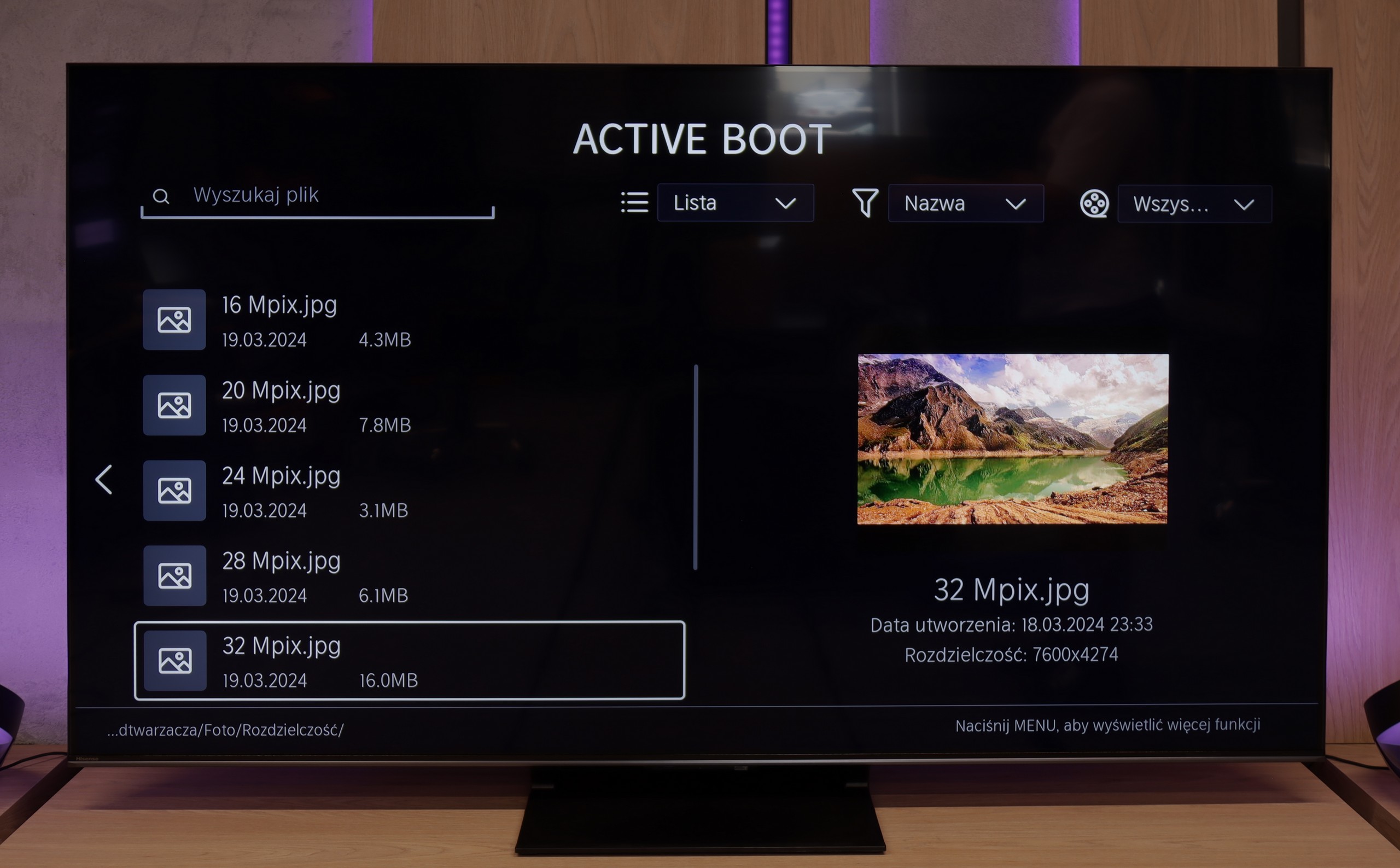
The built-in player in Philips OLED769 generally performs well. Although it may lack support for unusual formats, which could pose a problem for specific users, most should be satisfied with the available options. The built-in player in the TitanOS system allows for the reading of Polish characters and the changing of font colour, which additionally makes everyday use easier. Thanks to these features, playing files from USB is comfortable and versatile.
The built-in media player in the VIDAA system functioned very efficiently and without issues on our U7Q PRO unit. The television effortlessly read external video and audio files, as well as subtitles, making it convenient to watch films from a USB stick or external drive. Most popular formats worked flawlessly, so there was no need to convert anything. The only drawback was a certain selectivity in handling high-resolution images – not all of them opened. Therefore, you will find a detailed list of supported photo resolutions (Mpix) in our comparison table.
Apps
6.2/10
7.7/10














































Sound
6.7/10
7.8/10
- Subjective sound quality:6.7/107.8/10
- Dolby Digital Plus 7.1:
- Dolby True HD 7.1:
- Dolby Atmos in Dolby Digital Plus (JOC):
- Dolby Atmos in Dolby True HD:
- DTS:X in DTS-HD MA:
- DTS-HD Master Audio:
In the sound category, Philips OLED769 may not offer super dynamic sound, using speakers with a power of 2x10W. However, it is worth noting the support for all audio formats including Dolby and DTS. Thanks to this, despite the power limitations, users can enjoy high-quality sound with the help of external players.
Considering the standards of built-in television speakers, the U7Q PRO sounds surprisingly good. The sound is clear, with distinct mid and high tones, and the bass – although limited – doesn’t completely disappear. It can be said that for "television speakers," the level is more than satisfactory. However, it's worth noting that in our test unit we could not play sound in DTS:X format from local files – the television simply does not support it. This means that if you are counting on a cinematic spatial effect solely from its built-in speakers, there might be a certain disappointment. Fortunately, the television smoothly passes the DTS signal to an external amplifier, so if you have a home cinema – just connect it and everything works as it should.


